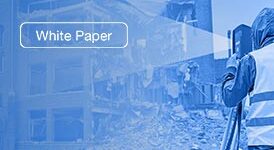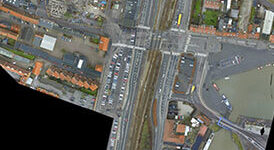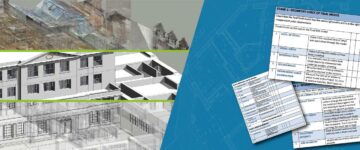- Scan to CAD provides high accuracy, time efficiency, rich data capture capabilities, and enhanced visualization in surveys. It helps build detailed as-built documentation and strengthens urban planning and environmental monitoring.
- Traditional land surveying techniques present various challenges for surveyors, including data processing complexities, greater time consumption, limited accuracy, and communication issues.
- Land surveying with Scan to CAD processes and tools and backed by AI and Machine Learning will reshape the industry and ensure greater surveying accuracy.
- Scan to CAD vector drafting, advantages and applications of Scan-to-CAD vector drafting in land surveying, are topics that surveyors need to understand today.
Table of Contents
Scan to CAD drafting processes and tools have transformed land surveying by introducing advanced scanning techniques with CAD-based software. Surveyors can now digitally represent and model complex structures, including topography and architectural elements, with greater reliability and accuracy.
The combination of laser scanning and 3D modeling enables surveyors to do better analysis, make accurate modifications, and optimize complex data. In this comprehensive guide, we’ll explore the workings of Scan to CAD for land surveyors, its principles, applications, advantages, and role in modern surveying.
The Traditional Challenges of Land Surveying
Traditional land surveying methods involve meticulous measurements using tools such as total stations and theodolites.
These methods, while accurate, are time consuming and labor intensive. Surveyors often face challenges, such as adverse weather conditions, difficult terrain, and lengthy data processing times.
Additionally, translating field measurements into detailed CAD drawings used in engineering and construction projects has historically been a complex and error-prone process.
Scan to CAD Vector Drafting
Scan to CAD vector drafting represents a fusion of two technologies: 3D laser scanning and computer-aided design (CAD). This synergy forms the cornerstone of modern land surveying and is critical for understanding how this process revolutionizes industry.
3D Laser Scanning
At the heart of Scan to CAD lies 3D laser scanning, a technology that has revolutionized data collection in land surveying. It operates by emitting laser beams that bounce off objects in the surveyed area, creating a rich and accurate point cloud. Each point within this cloud captures precise XYZ coordinates and often includes additional data, such as color and intensity. This meticulous data collection provides a digital replica of the real world that is both comprehensive and precise.
Data Processing
Once the point cloud data is gathered, it undergoes thorough processing using specialized software. This step includes data cleaning and noise reduction, aligning multiple scans (if applicable), and registering the scans to generate a unified 3D model of the surveyed area. This model serves as the foundation for Scan to CAD vector drafting.
CAD Integration
The 3D model seamlessly integrates into CAD software, bridging the physical and digital realms of land surveying. CAD empowers surveyors with tools for drafting, designing, and annotating within a familiar digital environment.
The Advantages of Scan to CAD Vector Drafting

Scan to CAD vector drafting offers a plethora of advantages to surveyors.
Enhanced Accuracy
One of the most significant advantages of Scan to CAD is its superior accuracy. Traditional surveying methods, which rely on manual measurements, can introduce errors. Scan to CAD minimizes such errors by providing precise digital representations of the surveyed area. By capturing the intricacies of the physical world in detail, CAD vectors faithfully preserve the original design. Higher accuracy driven by collaboration, analysis, and modifications boosts surveying confidence and the quality of the final product.
Time Efficiency
The scanning process is faster than traditional methods, dramatically reducing the time spent in the field. By transforming drawings or images into editable CAD files, surveyors can eliminate manual recreation to save substantial work hours.
Accurate digitization ensures precise measurements and detailing to mitigate human errors. Project timelines can be accelerated through smooth processes, allowing surveying teams to focus on innovation rather than on other demanding tasks.
Data Richness
Scan to CAD vector drafting showcase cutting-edge tools to enhance data richness through the conversion of physical objects into detailed models. Utilizing advanced scanning techniques supports surveyors’ capture of intricate geometry and CAD vector transformation. This process preserves the required design complexities and provides in-depth analysis, and modifications to ensure data richness.
Improved Visualization
Scan to CAD vector drafting has revolutionized visualization through the transformation of real-world objects into 3D digital models. This process ensures improved accuracy and allows designers to generate lifelike representations of complex structures. Better visualization drives an improved analysis, understanding, and communication of design intent to create detailed and visually captivating models and drawings.
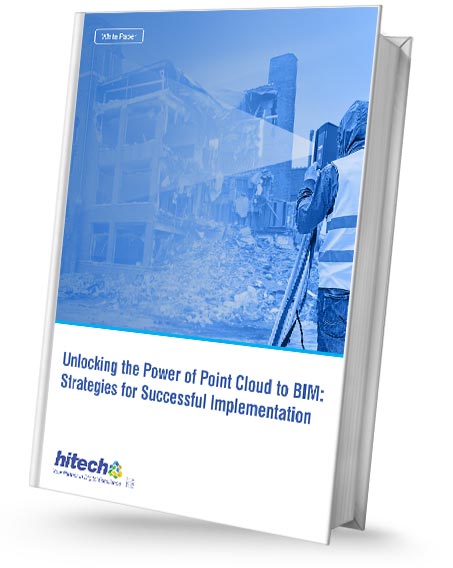
Unlock the Power of Point Cloud to BIM: Strategies for Successful Implementation
- Establish an accurate geospatial context for point cloud data.
- Simplify and optimize mesh representations of point clouds.
- Implement rigorous quality control procedures throughout the process.
- Adopt an iterative approach to modeling based on ongoing analysis.
Diverse Applications of Scan to CAD Drafting in Land Surveying

The applications of Scan to CAD vector drafting in land surveying are diverse and impactful, spanning a range of industries and domains.
Construction and Architecture
Scan to CAD vector drafting has modernized architecture, construction, and land surveying through the conversion of point clouds and scanned images into precise CAD vectors. This process supports construction teams through reliable As-Built documentation to save time and reduce errors.
Land surveyors benefit from the Scan to CAD process’s ability to capture complex site details to enhance surveying accuracy and efficiency. At the same time, Scan to CAD drafting improves workflows and elevates quality and project efficiency within architecture and construction.
Scan to CAD is widely employed in the construction industry. It aids in as-built documentation, clash detection, and seamless integration with Building Information Modeling (BIM). These applications ensure that construction projects align precisely with design specifications.
Environmental Monitoring
Scan to CAD vector drafting plays a significant role in land surveying for environmental monitoring through the conversion of scanned data into accurate CAD vectors. This technology helps create accurate and complete site plans, topographical maps, and elevation models for the assessment of environmental impact.
It enables land deformation detection, water bodies, and vegetation changes to provide valuable insights for environmental monitoring. Seamlessly integrating scanned data into CAD vector drafts, land surveyors can identify potential threats, assess land use, and plan conservation. CAD vector drafting enhances environmental monitoring to ensure sustainable conservation and land management.
Urban Planning
Converting scanned images of physical sites into accurate CAD vectors revolutionizes urban planning. This technology streamlines the process of collecting accurate spatial data to enable urban planners to generate detailed 3D models.
These 3D models help analyze land features, environmental elements, and infrastructure to optimize urban development. With Scan to CAD vector drafting, surveyors can capture terrain data, and reduce costs and time. Planners can make informed decisions, improve infrastructure design, and create green spaces. This evolved approach improves sustainability to ensure effective land use and infrastructure.
In urban planning, Scan to CAD vector drafting is instrumental. Surveyors create detailed 3D models of urban areas, streamlining the planning process, supporting infrastructure development, and enhancing disaster management strategies.
Historical Preservation
Scan to CAD vector drafting is an invaluable tool for historical preservation in land surveying. Digitizing historical sites by capturing accurate 3D data enables surveyors and preservation experts to build accurate CAD models. These models enable in-depth analysis, improved restoration, and greater architectural fidelity.
Digitized data fuels virtual reconstruction to understand the historical context of the site. Documentation through CAD vector drafting delivers an in-depth record for future needs.
Historical preservation projects benefit from Scan to CAD. Laser scanning and CAD drafting help document and restore architectural landmarks with a level of precision that ensures their preservation for generations to come.
Need precise Scan to CAD drafting services for your next construction project?
Streamline your renovation, retrofit or reconstruction projects with accurate modeling, drafting and detailed digital representation of topography of complex structures.
Scan to CAD Implementation Challenges
While Scan to CAD vector drafting offers numerous advantages, it is important to acknowledge the challenges and considerations associated with its implementation.
High Initial Costs
Investing in 3D laser scanning CAD software and tools incurs high costs in the initial phase, yet these investments yield long-term benefits. Substantial investments leveraged from these investments justify the financial outlay.
Specialized Training
To harness the full potential of Scan to CAD, land surveyors must undergo specialized training. Competence in operating equipment and software is essential to achieve optimal results. Transforming raw scan data into accurate CAD models with seamless integration, faster prototyping, and streamlined processes ensures productivity within the Scan to CAD framework.
Data Management Complexities
Handling large datasets generated by laser scanning can be complex. Surveyors must develop effective data management strategies to ensure data integrity and accessibility. Specialized training helps surveyors handle large datasets and ensure accuracy and drive accessibility. Resolving these complexities can streamline workflows, improve collaboration and optimize designs to offer precision and efficiency.
Potential Limitations
It is important to recognize that Scan to CAD may not be suitable for every surveying scenario. Surveyors should assess its applicability on a case-by-case basis, considering factors such as project scale and objectives.
Scan to CAD Success Stories
A leading European surveying firm needed 3D drawings extracted from scanned data for landscaping and road mapping of a large-scale project. They required detailed 3D vector CAD drawings of the location in accordance with local regulations, along with detailed building outlines, terrain, roads, landscape features, etc., to ensure a streamlined survey process.
The team at HitechDigital overcame the challenges of inferior quality of data and orthophotos, as well as notable delineations of building footprints. They made inferences based on point clouds with the help of orthophotos to produce precise positioning for vector mapping.
The team then converted the point cloud data into 3D Vector CAD drawings with drawing lines, polylines, polygons, and other geometric shapes for the land survey area. They also populated this area with lady survey terrain and road mapping of footprints, followed by annotations, labels, and dimensions.
The quality and accuracy of the Scan to CAD drafting helped the client save up to 20% of the project time and cost for the land surveying project.
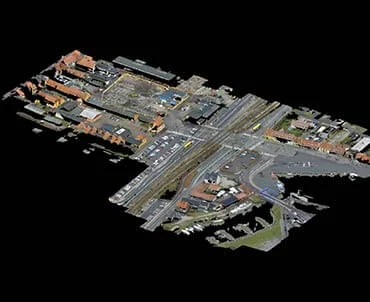 Point cloud Arial View of Project site
Point cloud Arial View of Project site
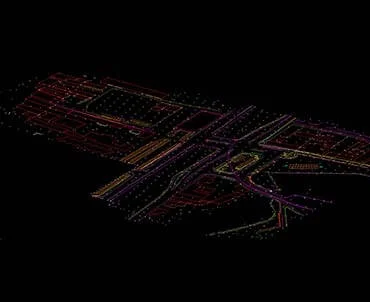 3D Vector Drawing View
3D Vector Drawing View
Future Developments and Trends
The future of Scan to CAD for land surveyors holds exciting possibilities, driven by ongoing advancements in technology and changing industry dynamics.
Advancements in Hardware and Software
Recent years have marked advancements within Scan to CAD technology through hardware and software sophistication. High-resolution 3D scanners equipped with cutting-edge sensors capture complex details for physical objects with complete accuracy. These scanners deploy advanced laser systems, and structured light techniques ensure precise data acquisition.
Powerful CAD software utilizes powerful algorithms to process data by transforming raw scans into accurate and detailed CAD models. These advanced developments possess streamlined workflows for faster project development cycles, error reduction, and design excellence.
Continuous innovation will make scanning equipment more affordable, efficient, and user-friendly. CAD software will evolve to offer increasingly sophisticated features, further enhancing its utility in land surveying.
Automation with AI and Machine Learning
Automation with Machine Learning and AI has transformed the Scan to CAD process for unparalleled precision and efficiency. Based on advanced algorithms, AI assesses scanned data to identify complex details and converts them into CAD models.
The use of Machine Learning (ML) algorithms refines the process by learning through various scans and improving accuracy over time. The combination of AI and ML within Scan to CAD drafting lowers manual errors and reduces costs and time. Complex structures that were once time consuming can be transformed into intricate CAD drafts.
Additionally, these tools optimize resource allocation for engineers to focus on creative innovation rather than repetitive tasks. ML, and AI have transformed Scan to CAD for faster, reliable outcomes, transforming the landscape of design and engineering.
The integration of artificial intelligence (AI) and machine learning is poised to revolutionize Scan to CAD. Automating certain tasks will boost efficiency, reduce human intervention, and enhance result accuracy.
Conclusion
Scan to CAD vector drafting represents a monumental advancement in the field of land surveying. Its ability to capture precise data, streamline workflows, and enhance visualization has established it as an indispensable tool for modern surveyors.
As technology continues to evolve, Scan to CAD will continue to play a pivotal role in driving accuracy, efficiency, and sustainability in land development and management practices. The profession of land surveying remains at the forefront of technological innovation, ensuring that the world beneath our feet is measured and understood with unparalleled precision.



